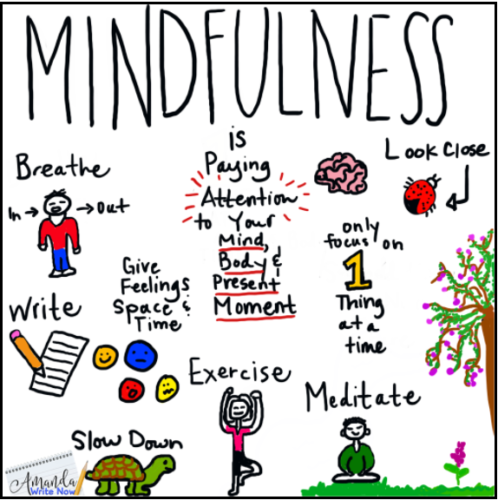In the bustling and often demanding environment of a classroom, the concept of mindfulness has emerged as a powerful tool for enhancing focus, reducing stress, and fostering overall well-being. This blog post explores the integration of mindfulness in the classroom, uncovering the benefits it brings to students and educators alike. Discover practical strategies, techniques, and the positive impact of mindfulness on focus, well-being, and academic success.

Understanding Mindfulness in Education
1. Defining Mindfulness
- Mindfulness is the practice of being fully present, aware of one’s thoughts, feelings, and surroundings without judgment. In the context of education, mindfulness involves bringing this present-moment awareness into the learning environment.
2. Mindfulness in Education
- Mindfulness in education emphasizes cultivating attention, emotional regulation, and self-awareness. It provides students with tools to navigate stress and enhances their ability to focus on learning tasks.
Benefits of Mindfulness in the Classroom
1. Improved Focus and Attention
- Mindfulness practices, such as mindful breathing and meditation, enhance students’ ability to concentrate on academic tasks, leading to improved focus and attention in the classroom.
2. Stress Reduction
- Mindfulness has been shown to reduce stress levels among students and educators. By promoting relaxation and a sense of calm, it creates a more positive and conducive learning environment.
3. Enhanced Emotional Regulation
- Mindfulness empowers students to understand and manage their emotions effectively. This emotional regulation contributes to a more harmonious classroom atmosphere.
4. Increased Resilience
- Mindfulness fosters resilience by teaching students how to approach challenges with a calm and composed mindset. This resilience is a valuable life skill that extends beyond the classroom.
5. Positive Impact on Well-being
- Regular mindfulness practices have a positive impact on overall well-being, contributing to improved mental health and a more positive outlook on learning.
Practical Strategies for Integrating Mindfulness
1. Mindful Breathing Exercises
- Incorporate simple breathing exercises into the daily routine. Guide students in focused breathing to help them center themselves and create a mindful start to the day.
2. Mindful Listening Activities
- Engage students in mindful listening exercises. This can involve listening to a piece of music, the sounds of nature, or even a classmate sharing their thoughts. This cultivates present-moment awareness.
3. Mindful Movement
- Introduce mindful movement activities, such as yoga or stretching exercises. These activities not only promote physical well-being but also encourage students to be present in their bodies.
4. Mindful Journaling
- Encourage students to keep mindful journals. This can include reflections on their emotions, gratitude, or moments of mindfulness throughout the day.
5. Mindful Awareness Practices
- Implement short mindful awareness practices during transitions between activities. This could be a brief moment of silence or a mindful walk from one part of the school to another.
6. Mindfulness Apps and Resources
- Explore mindfulness apps and resources designed for the classroom. These tools often provide guided meditations and activities suitable for students of various ages.
Mindfulness for Educators
1. Self-Care through Mindfulness
- Educators can benefit from mindfulness practices for their own well-being. Incorporate mindfulness into your daily routine to manage stress and enhance your resilience.
2. Modeling Mindfulness
- Model mindfulness for students by incorporating mindful practices into classroom routines. Your example will encourage students to embrace mindfulness as a valuable life skill.
3. Mindfulness Professional Development
- Attend mindfulness workshops or seek professional development opportunities focused on mindfulness in education. This enhances your understanding of the practices and their application in the classroom.
Overcoming Challenges in Implementing Mindfulness
1. Time Constraints
- Address time constraints by integrating brief mindfulness activities into existing routines, such as the beginning or end of the day.
2. Resistance from Students
- Introduce mindfulness gradually and provide explanations for its benefits. Engage students in discussions about mindfulness to create a positive and inclusive learning environment.
3. Cultural Sensitivity
- Be culturally sensitive when introducing mindfulness, recognizing that different cultural backgrounds may have varying perspectives on these practices.
Success Stories and Testimonials
1. Improved Classroom Dynamics
- Share success stories of classrooms where the integration of mindfulness has led to improved focus, reduced stress, and enhanced overall classroom dynamics.
2. Positive Student Feedback
- Showcase testimonials from students who have experienced the benefits of mindfulness in their academic and personal lives.
Mindfulness and Academic Success
1. Positive Impact on Academic Performance
- Explore studies and examples demonstrating the positive impact of mindfulness on academic performance, including improved grades and increased motivation.
2. Long-Term Educational Benefits
- Highlight the long-term educational benefits of incorporating mindfulness, such as enhanced learning engagement, positive attitudes toward learning, and improved cognitive abilities.
Conclusion
In conclusion, mindfulness in the classroom is a transformative practice that goes beyond simply reducing stress—it cultivates an environment where students can thrive academically and personally. By fostering focus, emotional regulation, and overall well-being, educators contribute to a positive and enriching learning experience. Mindfulness is not just a trend; it is a valuable tool that equips students with essential life skills for the challenges they may face in and out of the classroom.